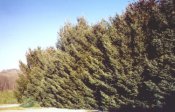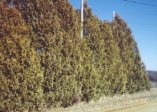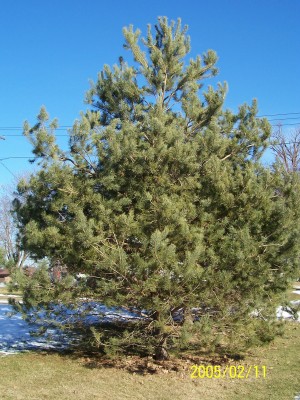Scotch Pine - pinus sylvestris
Due to serious disease problems we do not sell or recommend planting Scotch Pine anywhere.
7 year old Scotch Pine
The Scotch pine is a fast growing (2-3ft a year) evergreen that has a basic green needle that is arranged in bundles of two and is two to four and sometimes up to six inches long. Its needles are slightly sharp and on some trees sheds last years needles in October and on some trees will hold them for several years. Its branches only extend to the ground in its youth or when planted as a single tree. It is a native from England to Siberia and south to the Mediterranean
The Scotch pine can grow to 60 ft tall and 20 ft wide in most of the US, it does not have a large spreading root system and wind and ice storms can damage its branches. There are probably over 100 different varieties of Scotch pine in the Wild with about 10 favorites being planted in the US. It frequently develops multiple leaders and has an orange colored bark on branches of over 4 inches.
Being quite variable, species will grow from zone 2-7 and grows well in poor soils that many other evergreens would not. It will grow on almost any soil PH and has been planted extensively on sandy locations because of its ability to survive there. Used as a plantation Christmas tree in many areas of the country.
Branches and orange color
The Scotch pine has been planted extensively all over the US due to its adaptability. It is not a striking tree and becomes very open and deformed with age. As with all introduced species it was over planted thinking it was the “perfect tree”. Many different problems have become apparent including insects (zimmerman Pine Moth) and a disease called Pine Wilt. Pine Wilt is a major problem in the Midwest (Iowa, Illinois, Missouri, Kentucky, Nebraska, and Kansas) caused by a nematode that plugs resin canals in the tree causing death. Trees over 6 years old once infected, with no cure and death results rapidly. In other parts of the country this disease has not become a problem-yet.
A 2-ft tall potted tree can be over 10 ft tall in 5 years, in average soil adequate moisture, and weed and grass control around the base of the tree. Spacing--single row 16 ft apart, double row 16 ft apart, multiple rows--20 ft between rows and plants.
The Scotch pine is a recommended windbreak tree only in areas without the disease of Pine Wilt and may not live long if it moves into a new area. Most areas of the Midwest should not be used due to its short life (-10 years) being unacceptable for a long life windbreak. In most cases there are many other better windbreak trees that will give a long life without the worry of diseases. Check with your county extension agent on the current conditions of this tree in your area if wanting to plant.
I personally would not recommend planting scotch pine anywhere as the problems will only get worse.
We do not sell scotch pine, but many other places still do. They do not care about how long they live and will not tell you of the problems with this tree.
Kelly Tree Farm, 191 Quincy Ave. Clarence IA 52216 - PH: 563-452-4300 - ktf@netins.net
Yellow belly sapsucker bird holes. Common on many pine and Red Cedar. Does not seem to hurt the tree.





